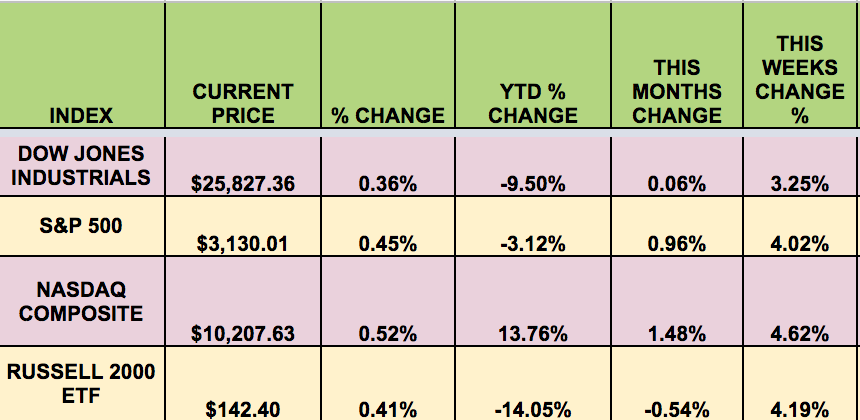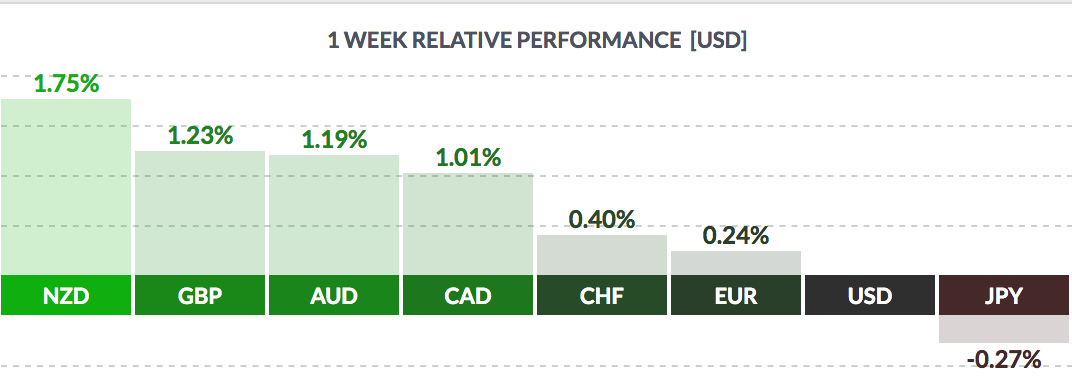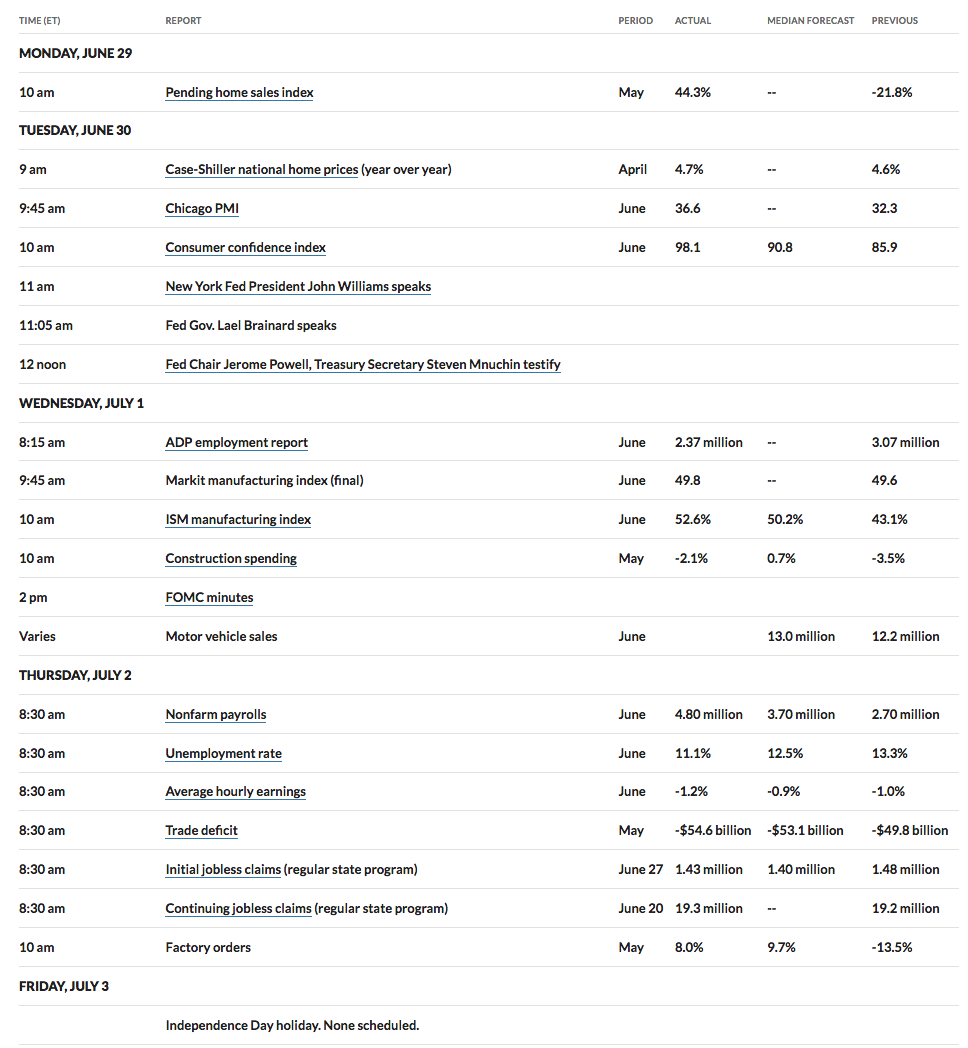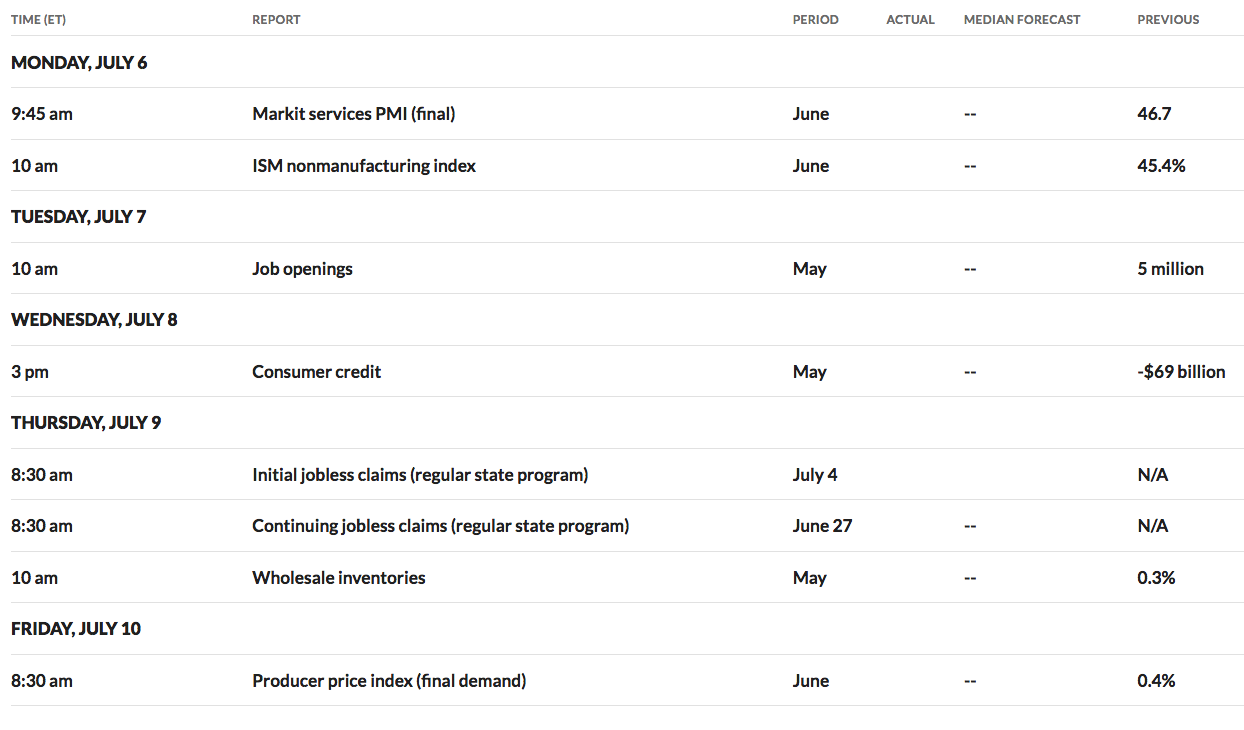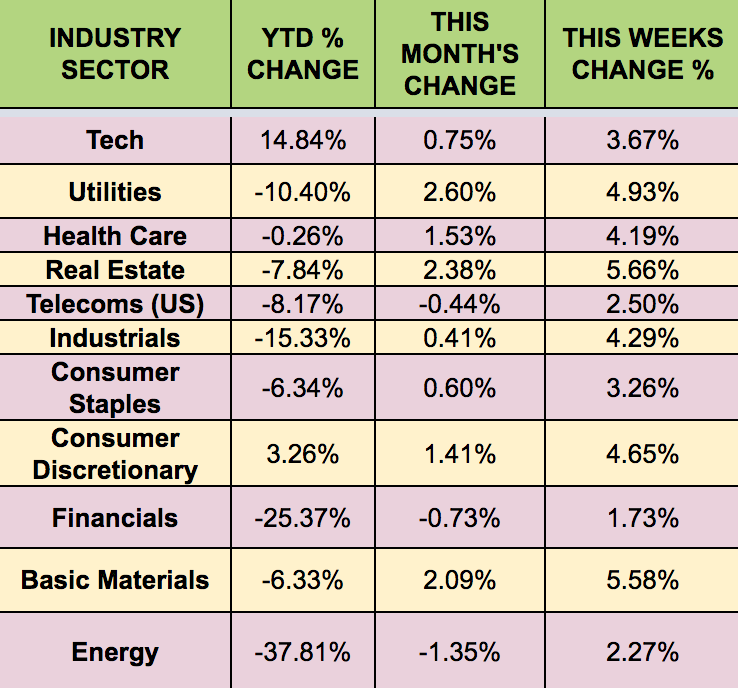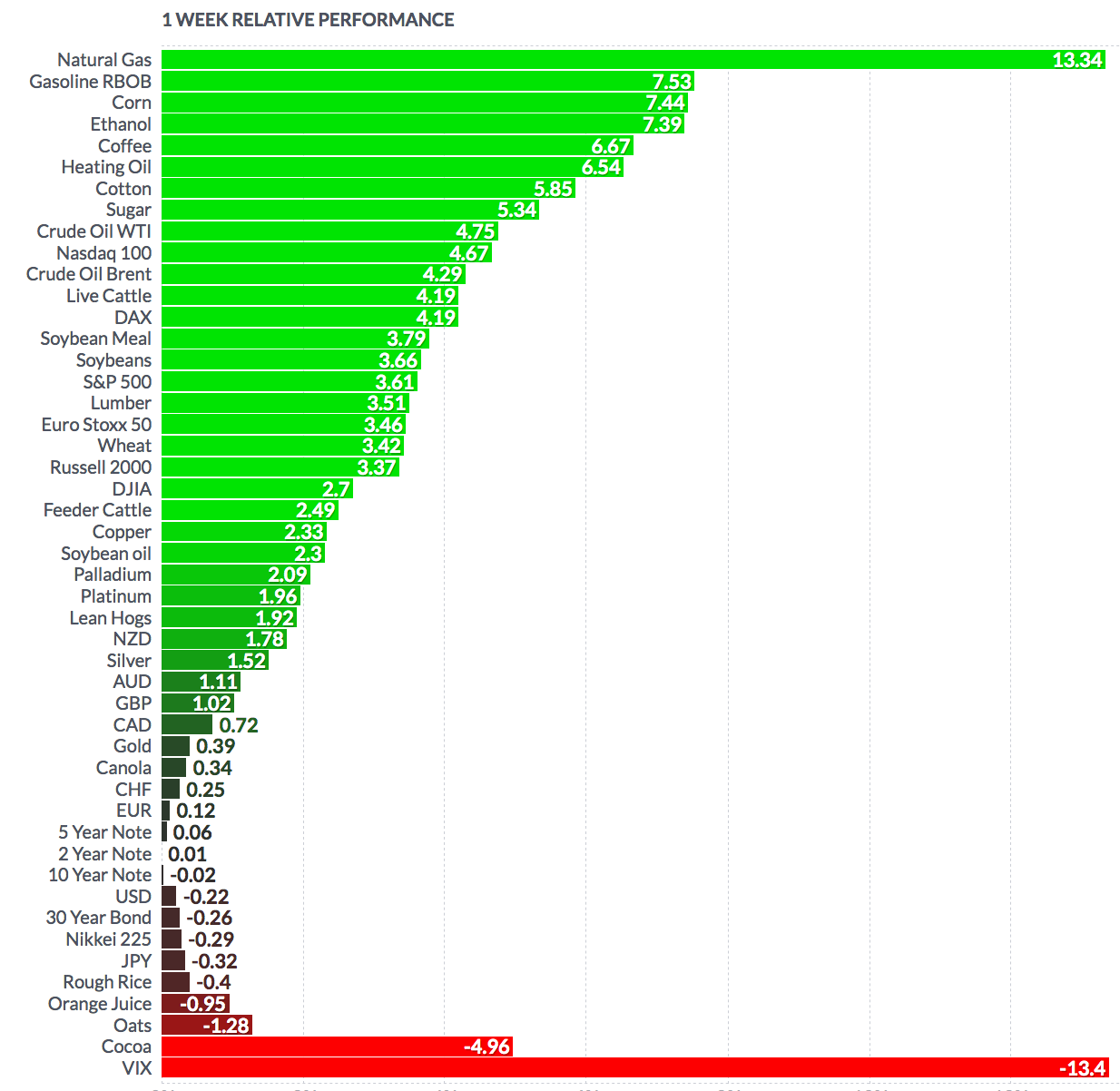“S&P 500 companies slashed or suspended over $40 billion in dividends in the second quarter, the deepest quarterly drop since 2009.” (Dow Jones)
Market Indexes
The market rose this holiday-shortened week, with all 4 indexes making solid gains, spurred on by upbeat economic news. In May, the US economy regained parts of the severe losses it incurred in March and April. The NASDAQ led, but was closely followed by the Russell Small Caps and the S&P 500.
Volatility
The VIX fell 20% this week, ending at $27.68, vs. $34.73 last week.
High Dividend Stocks
These high yield stocks go ex-dividend next week: BNS, BDO, CIO, KIO, LOAN, T, TD, WDR.
Market Breadth
19 out of 30 Dow stocks rose this week, vs. 9 last week. 74% of the S&P 500 rose, vs. 19% last week.
Forex
The USD fell vs. most major currencies this week, except the yen.
Economic News:
“The U.S. economy created a record 4.8 million jobs in June as more restaurants and bars resumed operations, but layoffs remained elevated and raging COVID-19 cases across the country threaten the fledgling recovery. The flare-up in coronavirus infections, which started in late June, was not captured in the Labor Department’s closely watched monthly employment report published on Thursday as the government surveyed businesses in the middle of the month.
The jump in non-farm payrolls in June was the largest since the government started keeping records in 1939. Payrolls rebounded 2.699 million in May after a historic 20.787 million plunge in April. Economists polled by Reuters had forecast payrolls increasing by 3 million jobs in June.” (Reuters)
“Total non-farm payroll employment rose by 4.8 million in June. The unemployment rate declined to 11.1%, the U.S. Bureau of Labor Statistics reported Thursday. These improvements in the labor market reflected the continued resumption of economic activity that had been curtailed in March and April due to the coronavirus (COVID-19) pandemic and efforts to contain it. In June, employment in leisure and hospitality rose sharply.
These gains reflect a partial resumption of economic activity that had been curtailed due to the coronavirus pandemic in April and March, when employment fell by a total of 22.2 million in the 2 months combined. In June, non-farm employment was 14.7 million, or 9.6 percent, lower than its February level.
Notable job gains also occurred in retail trade, education and health services, other services, manufacturing, and professional and business services.
The change in total nonfarm payroll employment for April was revised down by 100,000, from -20.7 million to -20.8 million, and the change for May was revised up by 190,000, from +2.5 million to +2.7 million. With these revisions, employment in April and May combined was 90,000 higher than previously reported.” (BLS)
“The Commerce Department said on Thursday factory orders increased 8.0% after falling 13.5% in April. Factory orders dropped 10.3% year-on-year in May. Manufacturing, which accounts for 11% of U.S. economic activity, appears to be regaining its footing, but a resurgence in coronavirus cases amid the reopening of businesses threatens the budding recovery.” (Reuters)
“Pending home sales in May spiked 44.3%, compared with April, according to the National Association of Realtors. Sales were still 5.1% lower compared against the same time last year.” (MarketWatch)
Week Ahead Highlights
It’ll be a quieter week on the economic front, with fewer reports due out. Q2 earnings season starts the following week. The resurgence in coronavirus cases in the US and other nations will most likely dominate the news and the markets.
Next Week’s US Economic Reports:
Sectors
Utilities and Basic Materials led this week, as all sectors posted gains. Financials lagged, weighed down by new Fed oversight rules. Tech and Consumer Discretionary are the year-to-date leading sectors.
Futures
Oil bounced back this week, rising 4.75%, ending at $40.28.
- English (UK)
- English (India)
- English (Canada)
- English (Australia)
- English (South Africa)
- English (Philippines)
- English (Nigeria)
- Deutsch
- Español (España)
- Español (México)
- Français
- Italiano
- Nederlands
- Português (Portugal)
- Polski
- Português (Brasil)
- Русский
- Türkçe
- العربية
- Ελληνικά
- Svenska
- Suomi
- עברית
- 日本語
- 한국어
- 简体中文
- 繁體中文
- Bahasa Indonesia
- Bahasa Melayu
- ไทย
- Tiếng Việt
- हिंदी
Oil And Equities Gain, While VIX Dropped 20% Last Week
Published 07/05/2020, 05:40 AM
Updated 07/09/2023, 06:31 AM
Oil And Equities Gain, While VIX Dropped 20% Last Week
Latest comments
Loading next article…
Install Our App
Risk Disclosure: Trading in financial instruments and/or cryptocurrencies involves high risks including the risk of losing some, or all, of your investment amount, and may not be suitable for all investors. Prices of cryptocurrencies are extremely volatile and may be affected by external factors such as financial, regulatory or political events. Trading on margin increases the financial risks.
Before deciding to trade in financial instrument or cryptocurrencies you should be fully informed of the risks and costs associated with trading the financial markets, carefully consider your investment objectives, level of experience, and risk appetite, and seek professional advice where needed.
Fusion Media would like to remind you that the data contained in this website is not necessarily real-time nor accurate. The data and prices on the website are not necessarily provided by any market or exchange, but may be provided by market makers, and so prices may not be accurate and may differ from the actual price at any given market, meaning prices are indicative and not appropriate for trading purposes. Fusion Media and any provider of the data contained in this website will not accept liability for any loss or damage as a result of your trading, or your reliance on the information contained within this website.
It is prohibited to use, store, reproduce, display, modify, transmit or distribute the data contained in this website without the explicit prior written permission of Fusion Media and/or the data provider. All intellectual property rights are reserved by the providers and/or the exchange providing the data contained in this website.
Fusion Media may be compensated by the advertisers that appear on the website, based on your interaction with the advertisements or advertisers.
Before deciding to trade in financial instrument or cryptocurrencies you should be fully informed of the risks and costs associated with trading the financial markets, carefully consider your investment objectives, level of experience, and risk appetite, and seek professional advice where needed.
Fusion Media would like to remind you that the data contained in this website is not necessarily real-time nor accurate. The data and prices on the website are not necessarily provided by any market or exchange, but may be provided by market makers, and so prices may not be accurate and may differ from the actual price at any given market, meaning prices are indicative and not appropriate for trading purposes. Fusion Media and any provider of the data contained in this website will not accept liability for any loss or damage as a result of your trading, or your reliance on the information contained within this website.
It is prohibited to use, store, reproduce, display, modify, transmit or distribute the data contained in this website without the explicit prior written permission of Fusion Media and/or the data provider. All intellectual property rights are reserved by the providers and/or the exchange providing the data contained in this website.
Fusion Media may be compensated by the advertisers that appear on the website, based on your interaction with the advertisements or advertisers.
© 2007-2025 - Fusion Media Limited. All Rights Reserved.

